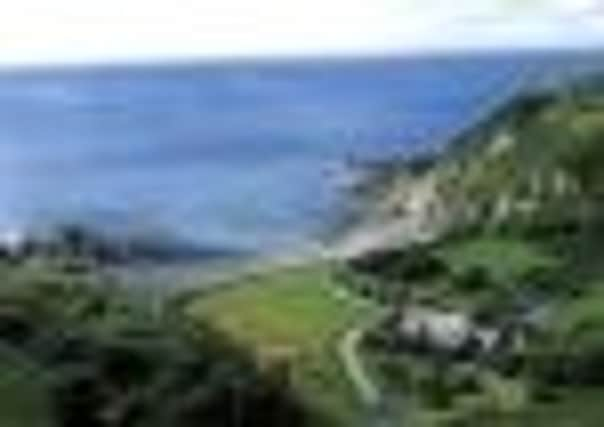Drift away in the other direction just for a change


Surely the point of a holiday is to leave the world behind for a bit. To truly get away, you have to go where most people don’t: the hidden places folk don’t know or think about. So instead of following the well-worn path north this autumn, why not head south?
Strike out for southern Scotland’s westerly edge: the remote Rhinns of Galloway. This hammerhead peninsula stretches 25 miles from Corsewell Point, gazing north to Ailsa Craig and Arran, down to the southernmost tip of Scotland, the Mull of Galloway, where a Stevenson lighthouse and an RSPB reserve of nesting puffins on sheer cliffs look out to Cumbria, the Isle of Man and Ireland, only 20 miles away across the Irish Sea.
Advertisement
Hide AdThe North Atlantic Drift keeps temperatures warmer in winter, which is why you’ll find tropical palms and flora at Logan Botanical Gardens. Look at the satellite picture of frozen Britain during the height of January’s snows, and the Rhinns are still green. The land’s remoteness keeps it one of Scotland’s secrets; it’s no accident Churchill chose to discuss the D-Day landings – the Allies’ greatest secret in the Second World War – with General Eisenhower at Knockinaam Lodge, now a romantic, secluded country hotel with a Michelin-starred restaurant and private beach.
The unspoilt coastline of rock face and sandy beach gives way to the seaside towns of Portpatrick, where legend says St Patrick set out for Ireland, Port Logan, where the BBC drama Two Thousand Acres of Sky was set, and Stranraer, at the head of Loch Ryan, sheltered from the Atlantic tempests.
Just to the east lies an ancient place of contemplation: the Machars Peninsula. Wigtown, Scotland’s National Book Town, is a book-lover’s haven, hosting an annual book festival (www.wigtownbookfestival.com) and 20 book businesses whose shelves creak under the weight of a quarter of a million new and second-hand books. The cradle of Christianity in Scotland sits 12 miles away at the atmospheric Isle of Whithorn, where our first saint, St Ninian, introduced Christianity to Scotland in the fourth century (www.whithorn.com).
“The Spirit of the Lowlands” has been distilled at Bladnoch, Scotland’s most southerly distillery, outside Wigtown, since 1817 (www.bladnoch.co.uk).
Travelling east along the Solway Coast to the Dee Estuary, Kirkcudbright’s beguiling medley of medieval, Georgian and Victorian architecture painted in pastel shades attracted famous Scottish artists from The Glasgow Boys and Scottish Colourists. Today, it is known as the ‘“Artists’ Town” for its galleries and studios. Nearby, Castle Douglas, Dumfries and Galloway’s “Food Town”, serves a feast of excellent regional produce.
Lockerbie Jazz Festival, from 30 September to 2 October, features boogie-woogie, jump and jive, swing and blues from jazz greats such as Acker Bilk and the Houston Person Sextet (www.lockerbiejazz.com), while on 6 October in Dumfries’ Easterbrook Hall, Scottish and Northern Ireland Opera present Offenbach’s Orpheus in the Underworld, rewritten by comedian and satirist Rory Bremner to mock the present day (www.dgarts.co.uk).
Advertisement
Hide AdMoving north, the Victorian spa town of Moffat is home to the celebrated Moffat Toffee, the world’s narrowest hotel – the 20ft-wide Star Hotel – and the Grey Mare’s Tail waterfall, cascading into the Moffat Water valley. The Southern Upland Way nearby continues on to Sanquhar in the Nith Valley, where you can send a postcard from the world’s oldest post office, dating from 1712.
Situated 1,531ft above sea level in the Lowther Hills, Scotland’s highest village, Wanlockhead, was called “God’s treasure house” for its mines of lead, zinc, copper, silver and some of the world’s purest gold at 22.8 carats, used to make the Scottish Crown.
Advertisement
Hide AdDumfries and Galloway joins the United States and Hungary in being awarded a Dark Sky Park – the first in the UK – in virtue of its exceptional night sky, free from light pollution. Gaze at more than 7,000 stars with the naked eye in near total darkness in the wilderness of Galloway Forest Park, Britain’s largest at more than 300 square miles and 210 million trees.
Galloway Forest is also great for mountain bikers, who can also ride any of the region’s five 7stanes courses: Glentrool, Kirroughtree, Dalbeattie, Mabie and Ae (www.7stanes.gov.uk). Cycle, too, the KM Trail from Dumfries to Keir Mill near Penpont: the birthplace of Kirkpatrick MacMillan, who invented the world’s first pedal bicycle in 1839. Dumfries and Galloway also boasts four National Nature Reserves: Caerlaverock, Silver Flowe, Cairnsmore of Fleet and Kirkconnell Flow. So if you want to get away, go to Dumfries and Galloway, and www.visitdumfriesandgalloway.co.uk.